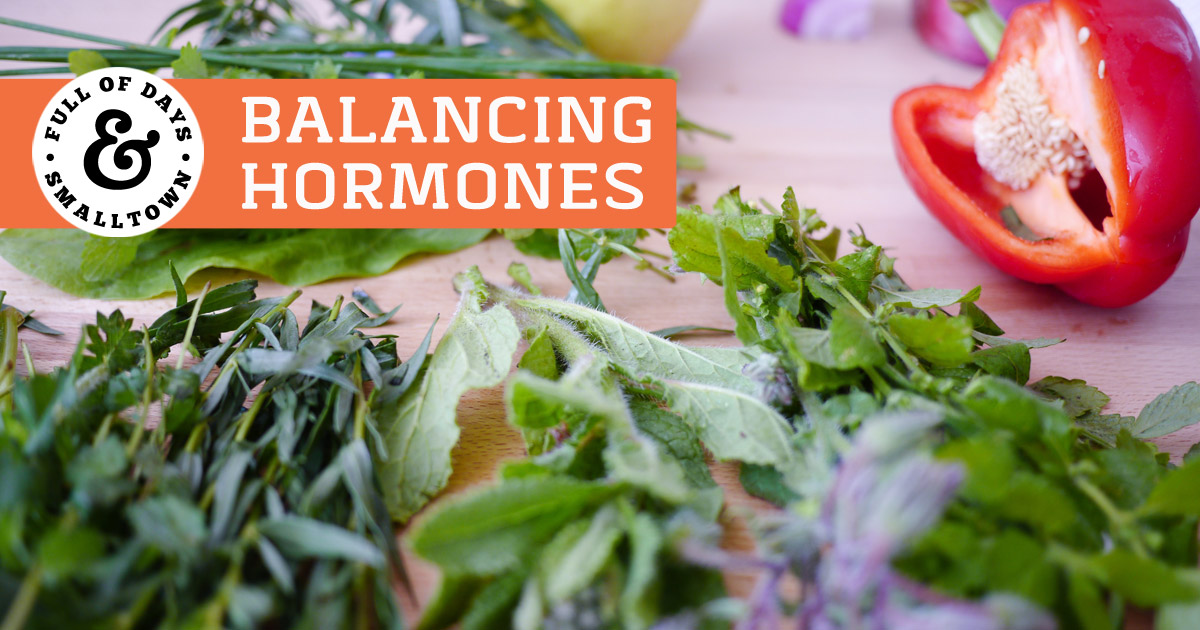
12 Crucial Steps to Balancing Hormones
Balancing hormones can be a stressful ordeal, and what makes a hormone imbalance worse? STRESS! Follow these 12 crucial steps to balancing hormones once and for all.
If you’ve experienced hormonal imbalances, you know what a pain it can be. And a hormone imbalance usually doesn’t correct itself but requires effort on our part, especially when it comes to diet and what food we allow into our mouth.
Thankfully for us, Magdalena Wszelaki has put together an amazing resource called Cooking for Hormone Balance: Re-balance Your Hormones with Food. It’s this resource that I’ve used as part of my own hormone balancing journey, and a bit of what I’ll share with you today. The best part about Magdalena’s plan is that most of the recommendations she makes are just plain healthy practices to live by. So incorporating them into your life can benefit more than just you…it’ll extend to your whole family.
I’ll be sharing a small summary of what’s available in her course, but take my word for it…if you’re struggling with imbalanced hormones, irregular/painful cycles, physical ailments like headaches/migraines or stubborn weight-gain or an inability to gain weight, you’ll want to check out Magdalena’s course.
UPDATE: The Ultimate Healthy Living Bundle is no longer available…but this FREE workshop is still available through this link. I highly recommend taking the time to watch the webinar. I know you’ll learn a ton!
Cooking For Hormone Balance: Re-Balance Your Hormones with Food
From Magdalena Wszelaki eCourse
1. Balancing Adrenals is Key
In order to balance adrenals, it’s important you’re getting enough high-quality healthy fat in your diet. Fat is a precursor for cortisol production (by the adrenals) and helps balance the sugar levels. Starting your day off with a breakfast that’s high in proteins, fat and fiber will ensure stable blood sugar levels and help adrenal recovery.
You’ll also need to pay close attention to stress levels, how much sleep you’re getting and excessive exercise. Be sure your diet is rich in superfoods (like bone broth, fermented foods and sprouted foods), magnesium, vitamins B & E and sea salt. Also, eliminating caffeine, alcohol and sugar are a must.
2. Anti-Candida Protocol
Candida is a form of yeast that can live in your mouth, intestines and on your skin. If our ratio of good to bad bacteria gets out of balance, candida can take over and weaken our intestinal wall. When this happens, toxins are released throughout the body causing damage to our tissues and organs and wreak havoc on the immune system.
If you suspect you have a candida overgrowth, it’s important to avoid sugars, alcohol, grains and glutinous foods.
3. Get Estrogen Under Control
If you suspect an estrogen dominance, you’ll want to include specific supplements to help with liver support and remove things like non-organic vegetables, conventionally-raised animal products, soy, caffeine, alcohol, toxins in your personal care & cleaning supplies, birth control pills and stressors.
4. Get Your Fats Straight
As mentioned with #1, fats are important for getting adrenals under control. But it’s important to understand which fats are healthy and helpful, and which ones are unhealthy and harmful.
It’s also important to know the smoke-points of all oils. Even if an oil is healthy, if it’s heated beyond the smoke-point, the oils become rancid and extremely harmful to our health.
5. Understanding Food Cravings
Our body loves to communicate to us. It sends us cues for what it needs, but unless we’re tuned in to what our body is telling us, we can easily mistake those signals for something else.
Food cravings are typically caused by certain foods, lack of certain nutrients, hormonal imbalances, dehydration and lifestyle behaviors.
6. Gut Health
When our gut health is compromised we’re guaranteed to have health issues. Sometimes it can be extremely difficult to “diagnose” a leaky gut, but it’s always what I tell people to look at FIRST, no matter what the ailment. From new or worsening allergies, to headaches/migraines and even hormonal imbalances. If our gut health isn’t strong, it’s unlikely we’ll find healing.
It’s important to add in gut-healing foods like broths, healthy fats, probiotics, fiber and possibly even supplements. At the same time, eliminating allergenic foods, processed foods, artificial sweeteners, caffeine, alcohol, stress and medications (under doctor’s supervision, of course).
7. Support Your Liver
In order to support your liver, there are certain foods and lifestyle changes that may need to be made. Foods like fiber, calciferous veggies, sulfur-rich foods and selenium can all support a healthy liver. But allergenic foods, medications, fluoride, caffeine and alcohol can all hinder liver function.
It’s also important to support your liver with a healthy lifestyle by removing all chemicals in our personal care products and cleaning supplies. While adding in healthy habits like getting to bed earlier, using magnesium oil or taking Epson salt baths.
8. Menopause Guide
If you’re of the age that menopause, or peri-menopause is a reality, there are steps you can take to help your body out during this change. By adding healthy foods like flax, sprouts, herbs and calcium and magnesium-rich foods you’ll be supporting your body through this change. And to further help, eliminate things that cause digestive distress, stabilize blood sugar, remove coffee and alcohol, harmful toxins and excess stress.
9. PCOS Support
Polycystic ovary syndrome can happen when hormone levels are out of balance. A woman’s body will cause cysts to form in the ovaries that are like tiny, fluid-filled balloons. Many times these cysts go unnoticed and even undetected, but if they get severe enough they can cause extreme pain, interfere with fertility and, in some cases, they can even be life-threatening.
There are certain foods that can be added to help support PCOS such as protein-rich foods, fiber, superfoods and herbs. Likewise, foods that should be avoided are sugary foods, caffeine and alcohol, and foods that cause digestive distress.
10. Balance that Blood Sugar
Constant fluctuations in your blood sugar can cause severe cravings, mood-swings and an overall sense of “ickiness” (as I like to call it). It’s important to maintain stable blood sugar to control cravings and help support our body’s functions.
To do this, eat a breakfast that’s rich in proteins, fat and fiber within an hour of waking. Eating enough fat with each meal helps slow down the absorption of sugar. Fiber helps slow down the metabolism of sugar. And foods with a low glycemic-index (GI) first thing in the morning will also help regulate blood sugar.
Again, avoiding foods that are high in sugar (fructose), contain artificial sweeteners or processed foods, caffeine, alcohol or allergenic foods is wise. Also, lower stress levels, get plenty of sleep and avoid late-night snacking.
11. Know your Sweets
It’s good to understand that not all sugars are created equal. If you haven’t watched the documentary called “That Sugar Film“, it’s worth every minute of your time to see just how sugar affects us.
Focus your diet on sugars closest to their natural state. Things like whole dates, raw honey, maple syrup, stevia extract and coconut nectar are your best bets.
12. Thyroid & Hashimotos
If you suspect your hormone imbalances are due to thyroid issues or Hashimoto’s, there are specific steps you’ll want to be sure to include in your hormone balancing protocol. A few of which are adding in liver support, zinc, flaxseed, turmeric and vitamin D.
You’ll also want to get your cortisol under control with the adrenal support guide. Likewise, get your blood sugars balanced and recognize your “triggers” that can set off symptoms.

Ready for Change? Start with a Meal Plan
Like I shared before, Magdalena was a jumping off point for my own hormone healing, but it took me hours of reading and research (and trial and error) to figure out what exactly would help. It wasn’t until I was ready to get serious about my diet that the true healing began.
Once I took the plunge to be serious about meal planning, and only allowing healthy food into my mouth for a solid month the changes came, and came fast!
Healing wasn’t complete after just one month, and to be honest, there are still small issues I’m trying to heal such as my sweet tooth that tends to pop up with regularity (and with it, unwanted side effects).
If you’re anything like me, you won’t stick to a meal plan unless you actually enjoy the foods you’re eating. This was the case for me, so anytime I tried a recipe that fit within my raw, plant-based meal plan, I jotted it down. I got really creative with breakfasts and lunches and eventually found a groove.
Because I don’t like to keep a good thing to myself, I decided I’d compile my favorite recipes into a 14-day meal plan complete with shopping list, recipes and daily menus.
Head on over here to see some sample recipes and daily menus and LET YOUR HEALING BEGIN!


